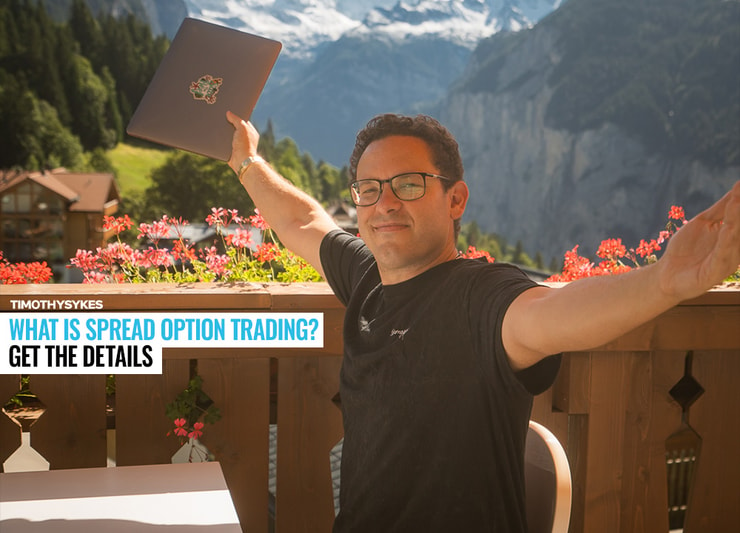Spread option trading is an options trading strategy that involves spread options. Spread options shouldn’t be confused with options spreads. They’re two different things.
So, what is spread option trading, and how does it differ from options spreads? Let’s dive in!
Table of Contents
What Is a Spread Option?
A spread option is an options contract that gets value from the spread between asset prices.
Most spreads are based on price differences between two or more assets. But spreads can also be based on interest rates, the production process, and currency differences. This means spread options aren’t just for stocks — you can also find commodity spread options.
An example of spread options using the production process is when you buy oil options. The value difference between crude oil and gasoline is called the ‘crack spread.’ It’s a more technical alternative to trading these commodities. If a trader thinks that refined products will grow in value compared to crude oil, they believe the crack spread will get stronger.
Spread options are unique because they draw value from multiple underlying assets. But aside from that, they act just like regular options contracts. That means you can implement spread options in your option spread strategies.
I know that sounds confusing, but bear with me…
Do you get taxed on options trading gains? Check out my post about taxes on options trading.
Example of a Spread Option

2025 Millionaire Media, LLCSpread options get their value from the price difference between two or more assets. These assets are usually different. For instance, you can buy an option for the stock price spread between Stock A and Stock B.
Sometimes spread options represent the same commodity or asset. They usually derive value from the price difference between a product’s input and output.
More Breaking News
- Orthocell’s Stock Surge: What’s Driving it?
- Will MP’s Rising Stock Trend Persist?
- JetBlue’s Mint Service Shakes Up the Skies
A good example of a spread option taking value from the spread between input and output is a ‘crush option.’ A crush option takes value from the price spread between raw soybeans and soybean oil. There are also ‘spark options’ between the price of electricity and its production cost.
Spread Option Strategies
Spread options behave similarly to regular options. That means you can use any option strategy with spread options.
That includes:
- Covered calls
- Covered puts
- Long calls
- Long puts
- Short puts
- Married puts
- Straddles
- Butterfly spreads
- Iron condors
You can also use options spreads with spread options.
What Is a Spread Transaction?
A spread transaction involves the simultaneous purchase and sale of options contracts. The combination of contracts must have related underlying stocks to be a spread transaction.
Traders make spread trades to produce a spread. Spreads represent the gap between the prices of these two options contracts.
Spreads usually have positive values. These spreads can be used to minimize your maximum risk. They can also improve your maximum profit potential.
Anything you can do to minimize your risk is important. Read my article on why options trading is risky.
How Do Options Spreads Work?

2025 Millionaire Media, LLCOptions spreads work when you trade multiple options with the same underlying asset. Options spreads are typically used to minimize risk. They can also increase your probability of success.
There are two main types of spreads:
- Horizontal Spread (aka Calendar Spread): In a horizontal spread strategy, you buy options with the same strike price but different expiration dates. Horizontal spreads let you profit from the options contracts’ time decay.
- Vertical Spread (aka Money Spread): In a vertical spread, you buy options with the same expiration dates but different strike prices. Vertical spreads limit your downside risk, but they also cap your potential profits.
There’s also a combination called a diagonal spread. In a diagonal spread, you buy options on the same asset with different expiry dates and strike prices.
Options spreads often use regular options contracts. But you can use spread options in your option spread strategies as long as the underlying asset is the same.
Options spreads are usually available for more advanced traders. Check out my guide to levels of option trading.
What Is the Best Options Spread Strategy?
There’s no one “best options spread strategy” for everyone. Each options spread strategy has different uses and fits different needs.
The best way to figure out what works for you is to try out every strategy you’re interested in. Keep a thorough trading journal, so you can see the strategies that actually work best for you!
Don’t try out “every” options strategy — at least not unprepared. Check out my guide to the best binary options trading platforms.
How to Close Your Spreads
Closing your spread means exiting the trade to avoid losses or to lock profits in. You can close spread positions at any time before your options expire.
How do you close the spread? You can close the spread by selling the options before they expire. You might not get maximum potential gains, but you’ll minimize your losses.
Stop-losses are a way to minimize risk when trading options. Read more about stop-losses in options trading.
Key Takeaways

2025 Millionaire Media, LLCSpread options and options spreads might sound similar, but they’re two different concepts.
Spread options derive value from the price differences between two assets. Meanwhile, options spreads are a popular strategy for hedging. Options spreads involve trading options at different strike prices or expiration dates.
Spread options act like regular options, and you can trade them with most options strategies. Meanwhile, options spreads use more advanced options strategies.
Experience and trading mentality are among the most important things when trading options. There’s no better way to improve them than to make trades, but you can’t go about it blindly.
I recommend getting some expert guidance. In the options world, I think there’s no better mentor than my former student Mark Croock.
Mark has racked up $4 million in career earnings, mostly from trading options. He’s done this by adapting my penny stock trading strategies to options. Before he was a teacher, he was one of my best students — watching every single webinar in the Trading Challenge 2 or 3 times!
Now he’s got his own mentorship program, called the Evolved Trader. Check it out for strategy sessions, trade alerts, a great chat room, and more!
Have you traded spread options? Let me know in the comments!









Leave a reply